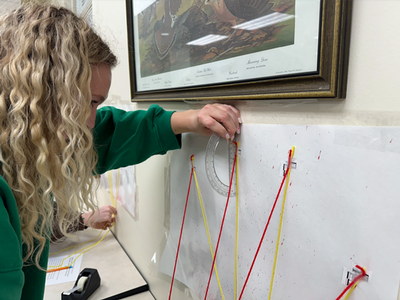
Forensic science has long been a subject of fascination, popularized by television dramas and real-world criminal investigations. Now, Samford University students can experience the field firsthand through the new Introduction to Forensic Science course, led by adjunct instructor Dan Matteo.
Interest in forensic science at Samford has been strong, and the new course has quickly become one of the most in-demand offerings in the biology department.
“Students have been asking for a course like this and it quickly filled up on the first day of registration,” said Anthony Overton, biology department chair and professor. “It’s an exciting blend of biology, psychology, sociology and law.”
Matteo, a retired forensic scientist with 25 years of experience at the Alabama Department of Forensic Sciences, brings a wealth of expertise to the classroom. His extensive background includes roles as a crime scene investigator and chemist specializing in drug analysis. With training from the DEA and FBI in forensic chemistry and photography, he aims to make forensic science accessible and engaging for students of all majors.
“This is the first semester we’re offering this course, and the goal is to make it both fun and educational,” Matteo said. “A class like this can spark interest in forensic science and show students the many career paths available in this field.”
Unlike traditional lecture-based courses, Introduction to Forensic Science integrates hands-on learning with real-world applications. Students engage in practical exercises that reinforce forensic techniques, including blood spatter analysis, laser trajectory mapping and crime scene documentation.
“A typical class includes a lecture followed by a hands-on component,” Matteo said. “For example, we discuss the difference between class and individual characteristics in forensic evidence—like shoe size versus a unique fingerprint. Then, students get to apply that knowledge in a lab setting.”
Senior biology and Spanish double major Stacy Estrada described the class as one of the highlights of her academic experience at Samford.
“This has been my favorite class at Samford since I transferred here last year,” Estrada said. “As someone who plans to go into forensics and become a forensic pathologist, I am incredibly grateful for all Mr. Matteo has done to help me further my connections in the field.”
Matteo emphasizes that forensic science is not limited to those pursuing a career in criminal justice. The field intersects with various disciplines, from biology and chemistry to law and health care.
“We need forensic pathologists, forensic scientists and even forensic nurses who understand how to handle evidence,” Matteo said. “Even law students can benefit from learning about forensic analysis and its role in court cases.”
With no prerequisites required, Introduction to Forensic Science welcomes students from all academic backgrounds. Matteo encourages anyone with an interest in science, investigation, or problem-solving to enroll.
“You don’t have to come in knowing anything about forensics,” he said. “Just bring an open mind and I’ll teach you everything you need to know.”
Due to high demand, the course will be offered every semester. As forensic science continues to evolve, courses like this one provide students with a glimpse into a dynamic and critical field—one where science meets justice and curiosity leads to discovery.
GIVE: Support impactful work at Howard College of Arts and Sciences.
